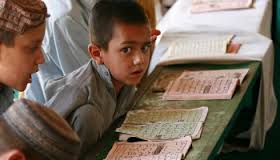THE condition of education in Bihar is not as encouraging as the state government wants us to believe. The government claims that lots of works have been done in the field of education in the state and the attendance ratio in schools has increased with every child going to school. But as one takes a closer look at the prevailing situation what he/she finds is that the government claims are far-fetched and detached from ground reality.
The central government allots approximately Rs 300 crore every five years for implementation of various projects related to education. This is not adequate, so the central government must increase its allocation for the state. But whatever amount is credited to the state, it is not being utilised properly.
There are corrupt leaders who have pocketed funds meant for spreading of education. Bad governance and inadequate education have a symbiotic relationship; one leads to the other. Generally bad governance is linked only to the state. But in Bihar, both the state and central governments are to be blamed for the lack of governance and the falling standards of education.
The majority of the rural population belongs to the lower castes and classes and have no means to send their wards to school. These children can be seen in the fields and other areas as child labour. Also the dominant perception among the people is that even if the children are educated, the state is not going to provide them employment.
If the children have to come back to the fields, why waste financial resources to educate them? Many parents and children perceive that the returns to schooling as much less than the returns from starting work earlier in life. In this background, Bihar’s most students finish their education learning their first lesson in corruption, crime and caste politics.
At the primary level, government schools are the only option for poor people, especially in rural areas. The government has failed to provide adequate infrastructure for these schools, in terms of buildings, teachers, etc. Many primary schools do not have even blackboards and chalk. In contrast, teaching standard in private schools is much better but fees are not affordable to most families. According to a recent survey, 210 primary schools across 21 districts, it was found that only 21.24% schools had regular teachers while the rest were on contract basis. It was also found that only 10.95% schools had all weather classrooms.
In a middle school in Alamganjwas, it was found that the condition of school has gone down as it has been developed in 2006 and by now no student is studying there. One primary school was running in hut. Only 43 percent of schools have separate kitchen for mid-day meal preparation. Eleven out of 21 districts have girls’ enrolment ratio below 50 percent of total strength of students. Only 34.76 percent have separate toilets for girls but some of them were locked.
If we talk about state capital Patna, according to a survey, 1,665 children living in different localities were found doing child labour as they were living in slums. Thirteen percent of them were found to drug addicts.
There are certain provisions for improving education. The central government too has passed various laws or bills like reservation of 25 percent seats in private schools for children on the basis of caste reservation, orphan, HIV affected, transgender. But the results are not encouraging. The quality of education has gone down also because most of the teachers are on contract basis. They are not trained, hence they don’t know how to teach.
A recent survey by National University of Educational Planning & Administration (NUEPA) has determined that only 21 percent of all primary school teachers in Bihar have completed Matriculation or 10th standard. Besides, teaching has also some unique problem. There is rampant copying and students threaten teachers if they act against their wishes. Researchers have found that 37.8 percent of Bihar’s teachers could not be found during unannounced visits to schools, the worst teacher absence rate in India and one of the worst in the world. According to one survey done by “Pratham”, most students studying in Classes V to VIII don’t even know how to read and write a simple sentence. Even many teachers were not in a position to write Hindi and English properly, which speaks volumes about the educational scenario in Bihar.
Without a proper system of education good governance will remain a distant dream in Bihar.
Yours truly,
Kumar Nishant , ‘People’s Democracy’, Bihar


